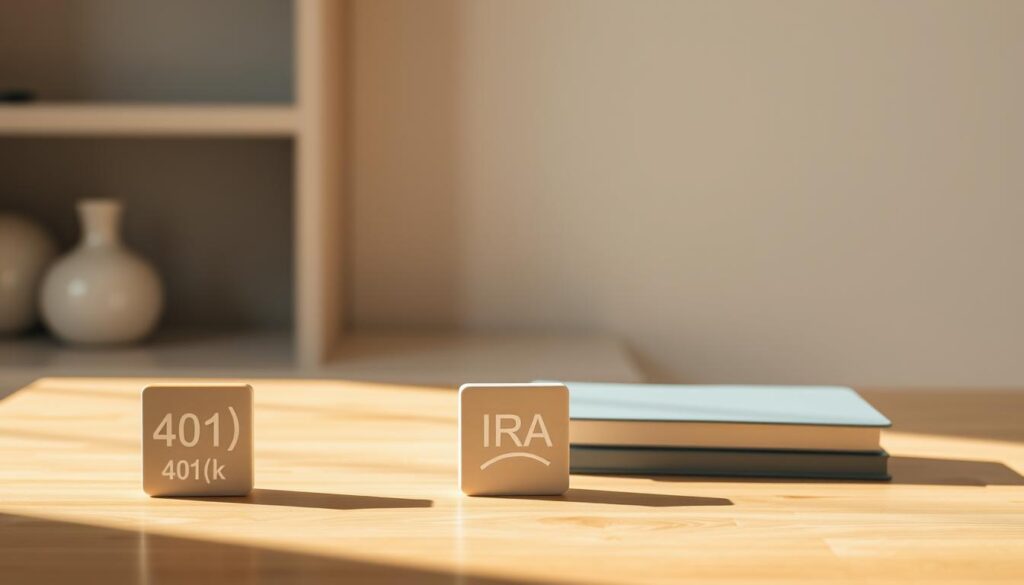The Basics of Retirement Planning for Beginners
A financially secure later life starts with a clear plan today. You can’t rely only on Social Security, so set simple steps to move from paycheck dependence to steady portfolio income.
Begin by estimating how much income you’ll need—many experts suggest aiming for 70%–90% of your pre-retirement pay. Choose the right accounts, automate savings, and pick investments that match your timeline and risk comfort.
Key ages matter: you can claim Social Security at 62, full benefits are near 67 for many, and delaying until 70 raises payouts. Use these milestones when you build your strategy.
Keep the approach practical: calculate needs, prioritize goals, and rebalance without reacting to every market swing. If you want help, a trusted advisor can align choices with your life and income goals.
Key Takeaways
- Start now: small, regular contributions add up over time.
- Estimate target income (often 70%–90% of current pay).
- Automate contributions and use tax-advantaged accounts.
- Know Social Security age milestones: 62, ~67, and 70.
- Focus on savings rate, diversification, and cost control.
What Retirement Planning Is and Why It Matters Right Now
Shifting from earned wages to portfolio income means choosing accounts, investments, and benefit timing that match your goals. This is an ongoing process—not a one-time task—and it should adapt as your life and the market change.
Why it matters today: rising healthcare costs, longer lifespans, and uncertain market returns can erode savings if you do not act early. A clear plan ties your desired lifestyle to an amount and a timeline.
From paycheck to portfolio: shifting your relationship with money
Think of this as a set of practical steps you revisit every few years:
- Define lifestyle goals and estimate the income you’ll need (many target roughly 70%–85% of pre-retirement pay).
- Pick accounts—401(k), 403(b), IRAs—and automate contributions to stay consistent.
- Balance growth-focused investments when you have time, then reduce risk as your age and time horizon change.
- Factor in Social Security timing: you can claim at 62, you receive full retirement age benefits near 66–67, and delaying to 70 raises benefits about 8% per year.
Retirement Planning for Beginners: How to Get Started Today
Figure out the yearly sum you’ll need to live comfortably, then break it into monthly steps. Start with the common rule: aim to replace about 70%–90% of pre-retirement income through savings and Social Security.
List core expenses (housing, food, transport) and add lifestyle costs like travel. Convert that annual target into a monthly amount so contributions link to a clear goal.
Set your “number”: estimating 70%–90% of pre-retirement income
Example: someone earning $63,000 would target roughly $44,000–$57,000 a year. Use that range to set savings rates and to size funds you need at retirement.
When to retire: aligning lifestyle with savings and full retirement age
Compare timelines: claim at 62, wait until full retirement age (67 for many), or delay to 70. Each choice changes Social Security benefits and the savings needed to bridge gaps.
Account for health care and Medicare in your budget
Healthcare can be one of the largest costs. Plan for Medicare Part B and D premiums, supplemental coverage, and rising out-of-pocket expenses over the years.
If you’re behind: use catch-up contributions, prioritize high-interest debt, and consider a 4% withdrawal rule to estimate how long funds might last. Schedule a simple 12-month plan and review it annually. An advisor can help validate assumptions and set realistic milestones.

| Scenario | Age to Start | Effect on Social Security | Typical Savings Action |
|---|---|---|---|
| Early claim | 62 | Reduced monthly benefits | Increase personal savings to cover shortfall |
| Full retirement | ~67 | Standard benefit amount | Balance withdrawals with lower risk assets |
| Delayed claim | Up to 70 | Higher monthly benefits | Use gap years to grow funds and reduce withdrawals |
| Healthcare focus | N/A | Costs rise with age | Fund HSA or emergency savings; budget Medicare premiums |
Choose and Use the Right Retirement Accounts
Your choice of workplace and personal accounts has a big effect on long-term savings. Start with employer-sponsored plans, since many employers offer a match that boosts contributions immediately.
Workplace plans and employer match
Contribute at least enough to capture the full employer match in a 401(k) or 403(b). That match is free money and speeds up fund growth.
IRAs: Traditional vs. Roth
Traditional IRAs offer tax-deferred growth and tax deductions now, but withdrawals are taxable and RMDs apply later in life. Roth IRAs use after-tax contributions and provide tax-free withdrawals, giving flexible income options in later years.
HSAs and triple tax advantages
Use an HSA for medical costs and long-term savings. Contributions grow tax-free and qualified withdrawals are tax-free, making it a powerful supplemental account.
Pensions, Social Security, and catch-up contributions
Pensions and Social Security supply baseline income that can reduce withdrawals from accounts. If you’re 50+, maximize catch-up contributions. In 2025, those aged 60–63 may use a “super” catch-up to add an extra $11,250 to employer plans.
Tip: Diversify across account types—pre-tax, Roth, and HSA—to control tax exposure and preserve flexible income in later years.

Building Your Retirement Investment Strategy
Crafting an effective investment blueprint starts with choosing the right mix of assets that match your goals and time horizon. This helps protect savings while giving money room to grow over time.
Asset mix basics: Use stocks for long-term growth and bonds for stability. Low-cost mutual funds and ETFs make broad exposure simple and affordable. Diversify across sectors and regions to reduce single-market risks.
Age-based risk and glide paths
When you are younger, tilt toward more stocks to harness compounding. As time shrinks, shift gradually into bonds to lower volatility. A simple rule is to reduce stock exposure by a few percentage points each year as you near your target date.
Automate, rebalance, and avoid overreacting
Automate contributions to keep savings disciplined through market ups and downs. Schedule rebalancing annually or semiannually to maintain your target mix. Avoid frequent trades after sharp market moves; steady rules beat emotional shifts.
When to use a financial advisor
Consider a financial advisor when you need help with complex decisions: tax-efficient withdrawals, drawdown sequencing, or coordinating accounts. An advisor adds value when goals and money choices get layered and technical.
| Focus | Primary Tools | Timing | Action |
|---|---|---|---|
| Growth | Stocks, equity ETFs | Long term | Higher allocation when younger |
| Stability | Bonds, bond funds | Near-term | Increase allocation as time shortens |
| Diversification | Mutual funds, ETFs | All stages | Spread risk across markets |
| Cost & tax | Low-expense funds, tax-advantaged accounts | Ongoing | Choose low fees and place assets tax-smart |
Timelines, Taxes, and Tradeoffs: Crafting a Plan by Life Stage
Map simple milestones by decade so your savings, accounts, and life choices stay in sync. Aim for roughly 1x salary by your 30s, ~4x by your 40s, about 8x by your 50s, and 10x by your 60s. These targets help shape contributions and tax decisions over the years.
Your 20s to 40s: emergency fund, debt strategy, and savings milestones
Build a 3–6 month emergency fund and pay down high-interest debt first. Contribute to your employer plan at least to the match while you chase early retirement savings milestones.
Tip: keep new debt in check as income grows and track progress toward multiples of salary to meet financial goals.
Your 50s to 70s: optimizing savings, Social Security timing, and withdrawals
Use catch-up contributions in your 50s to boost savings. Test how claiming social security at 62, at full retirement age, or waiting to 70 affects lifetime income and pressure on accounts.
Near and in retirement, formalize a withdrawal approach (starting point ~4%) and layer withdrawals by tax type to manage tax exposure.
Coordinating goals as a family and revisiting your plan after life changes
Revisit the plan after marriage, children, job changes, or caregiving. Mix pre-tax, Roth, and HSA accounts to smooth taxable income in later years.
If tradeoffs get complex, seek targeted advice from an advisor to weigh early versus later retirement age and to fine-tune tax and market assumptions.
Conclusion
A realistic money goal anchors every choice—from which accounts to use to how much to save each month.
Build your retirement plan around a clear income goal and the accounts that best match it. Use a mix of 401(k), IRA, and HSA to balance tax benefit and flexibility.
Fund low-cost mutual funds, ETFs, and core stocks, automate contributions, and rebalance on a schedule. Coordinate your timing with social security choices to stabilize long-term income and benefits.
Capture every employer match and use catch-up options as you age. Review the plan yearly, avoid reacting to short-term market noise, and, when goals get complex, consult a trusted financial advisor to refine investments and withdrawals.
FAQ
What is the basic goal of retirement planning and why start now?
The basic goal is to build a reliable income stream that covers living expenses, health care, taxes, and lifestyle choices after you stop working. Starting early gives compound interest more time to grow savings in accounts like 401(k)s, IRAs, and Health Savings Accounts (HSAs), and it reduces pressure to make large catch-up contributions later.
How do I estimate how much income I’ll need in retirement?
A common rule is 70%–90% of pre-retirement income as a starting target, adjusted for your expected expenses. Calculate current essential costs, add projected health care and leisure spending, then estimate income from Social Security, pensions, and savings to find the shortfall you’ll need to fund.
What is full retirement age for Social Security and how does it affect benefits?
Full retirement age (FRA) depends on your birth year—commonly between 66 and 67 for many people. Claiming benefits before FRA reduces monthly payments, while delaying past FRA (up to age 70) increases them. Timing affects lifetime income and interacts with other income sources and tax brackets.
Which accounts should I prioritize: employer plan, IRA, or HSA?
Start by contributing enough to your employer 401(k) or 403(b) to get the full employer match—it’s immediate return. Next, consider a Roth or Traditional IRA based on tax situation. If eligible, an HSA offers triple tax advantages for health costs and can double as a retirement savings tool.
How do Traditional and Roth IRAs differ and what about required distributions?
Traditional IRAs give tax-deductible contributions now and taxable withdrawals later; Roth IRAs use after-tax contributions and tax-free withdrawals. Traditional IRAs and workplace plans require Required Minimum Distributions (RMDs) starting at a set age, while Roth IRAs generally do not for the original owner.
When should I consider catch-up contributions?
Once you reach age 50, catch-up contributions allow higher contribution limits to 401(k)s and IRAs. Use them if you’re behind on savings or want to increase tax-advantaged retirement assets before claiming Social Security or retiring.
How should I build an investment mix as I approach retirement?
Younger investors often favor a higher allocation to stocks for growth, shifting toward bonds and cash as retirement nears to reduce volatility. Target-date funds or a rule-of-thumb allocation based on age can help, but adjust for risk tolerance, time horizon, and other income sources.
How often should I rebalance my retirement portfolio?
Rebalance at least annually or when allocations drift significantly from targets. Automating contributions and rebalancing reduces emotion-driven trades and keeps your asset mix aligned with long-term goals, without overreacting to short-term market moves.
Do I need a financial advisor, and how do they add value?
An advisor helps with tax-efficient withdrawal strategies, Social Security claiming decisions, asset allocation, and estate planning. Consider one if your situation is complex, you lack time or confidence, or you want personalized guidance; fee structure and fiduciary duty matter when choosing a professional.
How should different life stages change my approach to savings and debt?
In your 20s–40s focus on an emergency fund, paying down high-interest debt, and hitting savings milestones. In your 50s–70s prioritize maximizing contributions, reviewing Social Security timing, and planning withdrawal strategies. Major life events—marriage, children, divorce—should trigger plan reviews.
What role do pensions and Social Security play in a retirement income plan?
Pensions and Social Security are foundational predictable income components. Estimate their future payouts and combine them with personal savings, investments, and part-time work to shape a sustainable income strategy and determine how much to keep invested versus shift to safer assets.
How should health care and Medicare factor into my budget?
Include Medicare premiums, supplemental coverage, out-of-pocket costs, and long-term care possibilities in your plan. HSAs can offset medical expenses tax-efficiently if you qualify. Underestimating health costs is a common error—plan conservatively.
Can I use HSAs as a retirement savings tool?
Yes. HSAs offer tax-deductible contributions, tax-free growth, and tax-free withdrawals for qualified medical expenses. After age 65, non-medical withdrawals are taxed like an IRA, making HSAs a flexible, tax-advantaged component of retirement funding.
How do taxes affect withdrawals and timing of income sources?
Withdrawals from Traditional accounts are taxable; Roth withdrawals are tax-free. Coordinating withdrawals to manage tax brackets, capital gains, and Medicare premiums can preserve assets. Work with a tax advisor to design efficient withdrawal sequencing.
What steps should I take now if I haven’t saved much yet?
Start with an emergency fund, eliminate high-interest debt, and enroll in your employer plan to get any match. Increase contributions gradually, use catch-up options after age 50, and focus on low-cost index funds or target-date funds to rebuild savings efficiently.
